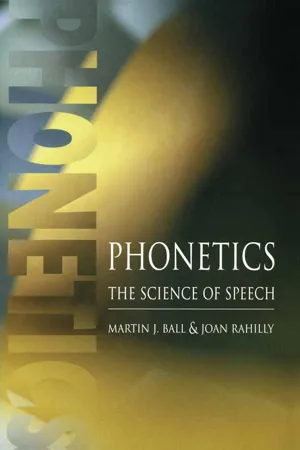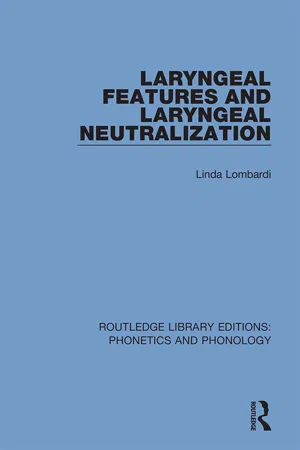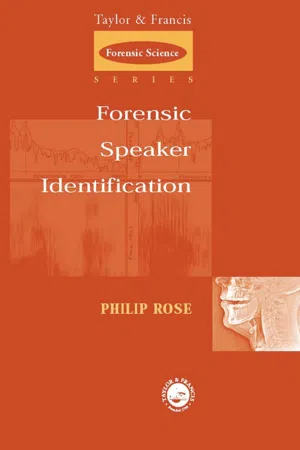Languages & Linguistics
Sonorants
Sonorants are a group of speech sounds that are produced with a relatively open vocal tract, allowing for resonance. They include vowels, nasals, liquids, and glides. Sonorants are characterized by their sonority, or acoustic energy, and are often contrasted with obstruents, which are produced with a more constricted vocal tract. In many languages, sonorants play a crucial role in syllable structure and phonological processes.
Written by Perlego with AI-assistance
4 Key excerpts on "Sonorants"
- eBook - ePub
Phonetics
The Science of Speech
- Martin J Ball, Joan Rahilly(Authors)
- 2014(Publication Date)
- Routledge(Publisher)
5Segments of speech: sonorant consonants and vowelsIntroductionNasalsApproximantsVowelsIntroduction ——————————————
In this chapter we will look at the different types of sonorant consonants (nasals and approximants, including lateral approximants and semivowels), and the vowels. This will then conclude our examination of the articulation of the segmental aspects of speech.Nasals ——————————————
As we noted in Chapter 3 , nasal stops can occur at a large number of places of articulation. However, in this section we will be concerned with two main areas of interest: nasals and phonation, and nasal–oral stop combinations. Nasals are hybrids in some respects in that, while they are made with a complete closure in the oral cavity (and so are stops), they have a comparatively free passage of air through the nasal cavity (and so are like approximants). That is why, although they were classed together with stops in Chapter 3 , they are categorized as Sonorants here. This reflects a difference between articulatory classifications and perceptual ones: terms such as ‘stop’ and ‘approximant’ refer to the way a sound is produced, while terms such as ‘sonorant’ refer to the sound quality we perceive.Although pulmonic egressive obstruents can occur both voiced and voiceless, Sonorants are much more commonly found voiced. As we will see, some languages do use voiceless Sonorants contrastively (and devoiced Sonorants may occur as positional variants), but because of the lack of turbulence in such sounds they lack acoustic power and are therefore much quieter sounds than their voiced counterparts. This is true of nasals as well as approximants. Nevertheless, some languages do make use of voiceless nasals, and some examples are given in Table 5.1. - eBook - ePub
- Vendryes(Author)
- 2014(Publication Date)
- Routledge(Publisher)
gn in French). These phonemes can be prolonged, but the air naturally escapes only through the nose, since the buccal occlusion prevents any passage of air. There are as many nasals as there are sonant occlusives. Those which correspond to the occlusive surds, and which are theoretically possible, are in fact somewhat rarely used.We have just seen that nasals possessing length and voice, entail a resonance from the nasal fossæ. That is to say, they are capable of playing the part of vowels as well as the liquids. Many languages in fact possess vocalic nasals, and we know that they were present in Indo-European. To-day they can be very clearly heard in the second syllable of the German words Atem and bieten. Furthermore, Indo-European used the nasals n and m as second members of a diphthong, and treated en, em, on, om, for example, like ei, eu, oi, ou. Ancient Greek preserved traces of this use in its accentuation, and Lithuanian still furnishes us with examples of the same thing.99 Meillet, XCIV, p. 89.Nasals perceptibly augment the list of sounds emitted by the human sound mechanism. But even with these we have not yet exhausted its possibilities. The reason why the list of possible sounds is almost limitless is that the elements composing them are for the most part interchangeable, and contain a number of variables.A vowel is pronounced on a definite note with a definite stress for a definite duration; and pitch, stress, and quantity multiply the varieties of every vowel. And as there can be different quantities in the same language, and since pitch and stress permit of modulations and intonations, these different varieties contain within themselves the causes for multiple variation.10 - eBook - ePub
- Linda Lombardi(Author)
- 2018(Publication Date)
- Routledge(Publisher)
CHAPTER 4 LARYNGEAL PHONOLOGY OF Sonorants 4.1 Laryngeal features of Sonorants 4.1.1 Sonorants and [voice] Both empirical and theoretical considerations lead to the conclusion that Sonorants are not marked with the feature [voice] underlyingly. The theoretical considerations have to do with the theory of underspecification: voicing is predictable in Sonorants, and therefore [voice] is redundant and should not be marked. There are also phonological facts that require that Sonorants be unspecified for [voice]. A well-known example is Lyman’s Law in Japanese (see Ito and Mester 1986). The initial consonant of the second member of a compound becomes voiced by the rule of Rendaku (1a). This rule is blocked if the second word contains a voiced obstruent (1b), but is not blocked by the presence of a sonorant (1c): (1) Of course another type of example that shows that Sonorants are unspecified for [voice] is the phenomenon of voicing assimilation discussed in the previous chapters, where [voice] does not spread from Sonorants, and in cases such as Polish we can see that Sonorants are actually transparent to the spread of [voice]. Another case that shows that Sonorants cannot be marked [voice] in the phonology comes from Burmese (Okell 1969). Burmese has voiced, voiceless, and aspirated stops, and voiced and aspirated Sonorants. There is a process of voicing the initial of the second member of a compound, and a noun can be derived from a verb by voicing the initial consonant. Voiceless and voiceless aspirated obstruents can undergo voicing, so for instance /k h / becomes /g/, as does /k/. The rule presumably links [voice] to the consonant, and if [asp] is present it deletes, since the two features cannot cooccur in this language. However, the aspirated Sonorants do not undergo this rule–there is no change in them in this position. This is evidence that it would be impossible to link [voice] to a sonorant without creating an ill-formed representation - eBook - ePub
- Phil Rose(Author)
- 2002(Publication Date)
- CRC Press(Publisher)
manner of articulation).Vowels are produced by modifying the shape of the supralaryngeal vocal tract in non-radical ways. By primarily moving the tongue body and changing the lip aperture, the vocal tract is effectively squeezed at differing locations along its length, creating vocalic resonators of different dimensions. By lowering the soft palate an additional set of nasalised vowels can be produced, and vowels can also be produced both long and short. More than one vocalic target can be produced in a syllable, giving rise to diphthongs and triphthongs. These modifications can be described phonetically in terms of the vowel’s height, backness, rounding, nasalisation, length and dynamicity. Speech sounds are analysable and describable in terms of smaller components called features.Suprasegmentals: Stress, intonation, tone and pitch accent
In the previous sections, the production of vowels and consonants was described. These sounds are referred to as segmental, the metaphor being that they are strung together like segments in a word. A second major class of speech sounds – that containing intonation, stress, and tone – is called suprasegmental, the inference being that they in some sense exist on top of the segmental sounds. This inference is somewhat misleading because intonation, stress, and tone are mostly associated with laryngeal activity, which, if you are speaking standing up, even in Australia, takes place below the other speech-producing organs.Stress has to do with the relative prominence of syllables within a word. Tone has to do with the use of different pitch shapes to signal word identity, and intonation has to do with the use of pitch to signal features of utterances longer than the word. These, together with another suprasegmental category called pitch accent, will be discussed and exemplified below.
Index pages curate the most relevant extracts from our library of academic textbooks. They’ve been created using an in-house natural language model (NLM), each adding context and meaning to key research topics.
Explore more topic indexes
Explore more topic indexes
1 of 6
Explore more topic indexes
1 of 4



